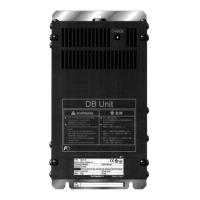9.1 Overview of RS-485 Communication
The FRENIC-Ace has two RS-485 communication ports at the locations shown below.
(i) Communication port 1: RJ-45 connector for the keypad (modular jack)
(ii) Communication port 2:
RJ-45 connector for RS-485 communication (modular jack) * only for type FRN-E2■-2/4/7GA, -2/4/7J;
RS-485 terminals (control circuit terminals SD, DX-, DX+) * only for FRN-E2■-2/4/7GB, -4C
COM port 1 COM port 2
Using the RS-485 communication ports shown above enables the extended functions listed below.
• Remote operation from a keypad at the remote location (COM port 1)
The standard keypad enables remote operation by mounting the keypad on a remote panel and connecting the
keypad to RJ-45 connector with an extension cable. (maximum cable length: 20 m)
• Operation by FRENIC Loader (COM ports 1 and 2)
It is possible to edit and monitor the function codes by connecting the RJ-45 connector (RS-485 communication)
in the inverter and PC and using the inverter support loader (FRENIC Loader, see “9.3 FRENIC Loader
Overview”).
• Control via host equipment (COM ports 1 and 2)
Connecting the inverter to the host equipment (upper controller), such as a computer and programmable
controller (PLC), enables to control the inverter as a subordinate device.
Besides the communication port 1 (RJ-45 connector) shared with the keypad, the FRENIC-Ace has the RS-485
communication port 2 by default.
The protocols for controlling inverters support the Modbus RTU protocol (compliant to the protocol established
by Modicon Inc.) that is widely used and the Fuji Electric’s general-purpose inverter protocol that is common to
Fuji Electric’s inverters including conventional series.

